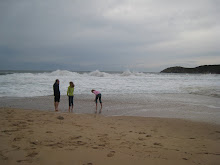 Friends arrive for a visit tomorrow. They'll rent a car at the airport and drive up to us. Earlier this week, when I offered to send C to meet them, they replied with assurances that they could find their way and a copy of the map of our neighborhood provided by their GPS.
Friends arrive for a visit tomorrow. They'll rent a car at the airport and drive up to us. Earlier this week, when I offered to send C to meet them, they replied with assurances that they could find their way and a copy of the map of our neighborhood provided by their GPS.The map was wrong.
It wasn't wrong in the broadest sense--the red dot representing La Bastiole was in approximately the right place on our lane. But it was wrong more narrowly, in that it showed La Bastiole as sitting at the corner of our lane and another road, a road that wrapped around La Bastiole and, somewhat further down the hill, met up again with our lane.
There is no such road.
Now, to be fair, there is a disused road behind our house. It's the path that the dogs and I take to the village most days. But it leads up the hill, not down, and it meets up with a different lane entirely.
Our friends' GPS is not the first instance of satellite confusion we've run across. The village had maps printed up recently--glossy brochures showing exactly how little there is in the way of commerce--and on that map, too, this mystery road appears.
I pointed out the discrepancy between reality and satellite imaging to C, who believes in technology more than I. His first response was that the phantom road must be the path up to the village. It may be that I made a sound like a snort at that juncture. We've been on that path a hundred times, and we know where it goes. Then he mentioned the path below our house, the one that goes across the hill to the next village. C thought maybe that was what the GPS was showing as a road. Neither, though, does that path follow the map's outlines. And heaven help the person who tries to drive a car along it: mud, stones, and a spot where there's a blackberry bramble on one side and a 20 foot drop on the other, where you have to go single file and where the dogs cast doubtful looks over their shoulders at me every time.
How hard it is to believe the evidence of our eyes versus the certainties of a global positioning system. Our whole sense of the world, these days, is staked on technology being right. On the Internet being able to link us to truth in under 2 seconds. Even as I write this, I wonder if I'm not somehow misreading that map, misunderstanding its representation of the lane that I drive up and down every day--wondering if, if I just turned my head a little, I would see that, in fact, there is a road where the GPS says there is. After all, there must be, mustn't there?
Apparently there's a village in England that has had similar troubles with the GPS. Wedmore's lanes are too narrow for sidewalks, yet they turn up as the shortest route to the Bristol airport. 15,000 vehicles a day go down it nowadays, passenger cars as well as camions. Villagers have had their front gates sheared off, lost their mailboxes, found the side mirror of their cars snapped off on the ground. When asked, the spokesman for the GPS guys said: We map the reality. We cannot change that reality in our database. Who are we to make a change and say, ‘You cannot drive in that road’ if, in reality, you can drive in that road.
Except for when you really can't, not if you've got more than four wheels. Or if the road, like our phantom, doesn't exist.
C's going to meet our friends at the airport and lead them home.






































Thanks to the GPS, we've had several big tourist buses drive up the street where I live, whereas this street is too narrow for big vehicules.
ReplyDeleteThere are signs at the beginning of the street saying big vehicules can't drive up this street, but the drivers just blindly follow their GPS, and don't even look at the street signs anymore...
One of these buses was stuck there for several hours, and even the police didn't know what to do with it!!!
Yay, to new technologies ;)
My favourite thing about that NY Times article is the little definitions it keeps inserting to explain Britishisms to the Americans!
ReplyDelete